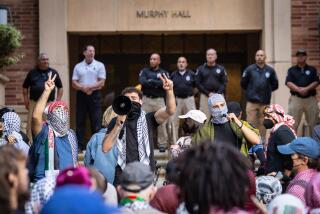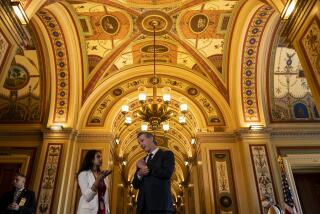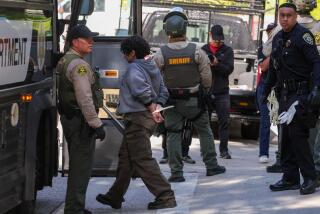RIOT AFTERMATH: GETTING BACK TO BUSINESS : NEWS ANALYSIS : Wilson’s Handling of Disaster: So Far a Passing Grade
SACRAMENTO — Gov. Pete Wilson had just returned the night before from touring earthquake devastation along the North Coast and was mulling over the latest depressing figures from the state budget crisis when an aide told him about the Rodney King verdict.
“I was stunned by the verdict,” he recalled. But he did not spend much time talking about it. He immediately directed the aide to contact the National Guard, the California Highway Patrol, the Office of Emergency Services and all other state agencies that could be called upon if violence erupted.
The ensuing riot--in which more than 50 were killed, more than 10,000 arrested and more than 3,000 businesses destroyed or damaged--far surpassed anything state or local officials had envisioned in their worst nightmares. And for Wilson, it was the latest in an unprecedented series of disasters and crises that have afflicted his governorship.
There also have been a crop-killing freeze, a fifth and sixth year of drought, the devastating Oakland hills fire, killer floods in Southern California, and the severe earthquakes near Palm Springs and on the North Coast. For wear and tear on a governor--and potential political pitfalls--add in a nagging national recession that has led to unprecedented state budget deficits, and a legal battle over the state’s first execution in 25 years.
“I doubt there has been another 16-month period like this in the history of the state,” Wilson said in an interview. “I clearly didn’t expect every natural disaster known to man. It’s been like a biblical litany.”
So far, the governor appears to have weathered the Los Angeles riots--as he had the previous disasters--without looking foolish, which is about the best politicians in his position can hope for. By contrast, Wilson did suffer a damaging blemish, according to the polls, with his handling of last year’s budget crisis, when he substantially raised taxes.
“Governors dread crises because they’re basically remembered by how they react to them,” said Steven A. Merksamer, who was Gov. George Deukmejian’s first chief of staff. “They’re a wonderful opportunity to demonstrate bold and strong leadership. But they’re also an opportunity to be blamed for things if they don’t go well.
“There are always two stories in a crisis: The first is the disaster itself. The second is who screwed up. That’s why crises can--and do--make or break political careers.”
Virtually every state officeholder knows that when the Watts riot erupted in 1965 then-Gov. Edmund G. (Pat) Brown was vacationing in Greece. “Where was Pat?” became a one-liner in Ronald Reagan’s winning campaign against Brown in 1966. Brown’s lieutenant governor, Glenn Anderson, hesitated in calling out the National Guard and also lost reelection.
At Mayor Tom Bradley’s request, Wilson quickly activated the Guard shortly after violence erupted Wednesday night--a move initially opposed by Police Chief Daryl F. Gates and Sheriff Sherman Block, according to the governor--but his image still could be tarnished if he is found to be partly responsible for the Guard’s slow deployment while killers, looters and arsonists ran amok.
Wilson has reported being “frustrated” and “angry” at the Guard because it was reluctant to go into the streets without all its ammunition, plus a part necessary to convert an automatic rifle to semiautomatic. On Monday, he called the Guard’s delay “inexcusable.” He has ordered an inquiry and said that “someone’s head may very well roll.”
The governor said he finally ordered troops into the streets Thursday afternoon without all their ammunition and weapon parts, asserting that each man should be “given a round or two. Then he won’t have to worry about the rate of fire. He can have his own ammunition control, which is not a bad idea in any case.”
Finally about 6 p.m. Thursday, the Guard’s full complement of ammunition--totaling 350,000 rounds--arrived at the Los Alamitos Armed Forces Reserve Center in Orange County, according to the governor’s office. So far, very few rounds have been fired.
Veteran political consultant Joseph Cerrell of Los Angeles, a Democrat, is not so sure the Republican governor can escape blame for the Guard’s slow deployment.
“I think he came through this pretty good, but he could have come through better,” Cerrell said. “He was honest in reporting about the Guard screw-up and that’s a plus. But the public may not be as kind about the fact the Guard didn’t have bullets. Some people aren’t going to be so forgiving.”
Cerrell also said Wilson “definitely” should have flown immediately to Los Angeles Wednesday night, instead of waiting for nearly 24 hours. “People would have liked to have seen him come here and take some responsibility as head of the National Guard,” the consultant said. “Once he got here, the governor came across as forceful and very cooperative with the Democratic mayor.”
What the weary Wilson did, instead, was to hold a Capitol press conference at midnight Wednesday that was televised live in Los Angeles. In his remarks, the governor sought to tread a delicate line between condemning the rioters and not stirring further unrest. He acknowledged being “surprised” at the verdict in the trial of four LAPD officers.
But the governor seemed halting and nervous--a result, aides later said, of his exhaustion after the execution of double murderer Robert Alton Harris and the North Coast earthquake trip, all within a week.
Wilson decided by midafternoon Thursday to go to Los Angeles after becoming angry at the Guard. He told reporters he wanted “to be a little nearer to the people who are involved”--meaning officials making decisions.
The governor also said that “in a time of crisis, it’s essential for the public to feel as much reassurance as it can that assistance is on the way, that there will be a solution to the problem. You need to do that with great speed and with great certainty and with visibility. You can’t tell the public things that are not true, but you need to communicate what, in fact, is being done to alleviate their distress.”
Since last Thursday night, Wilson has been all over Los Angeles--and all over television--visiting guardsmen, religious leaders, Korean-Americans, Latinos, blacks and business leaders, while meeting with local officials and holding press conferences.
“I think Wilson did fairly well, and given the peril of the situation was not hurt too much,” said veteran political observer Mervin D. Field, director of the California Poll. “He probably has come out of it, so far, as well as could be expected.”
But one potential embarrassment could develop, others pointed out, if it turns out that Wilson and his advisers were unprepared for the riot. In the Deukmejian Administration, there was an Emergency Operations Council centered in the governor’s office that involved all the relevant state officials and met regularly. It even conducted periodic surprise exercises, simulating various disasters.
Under Wilson, this governor’s council has been virtually inoperative and there have been no drills.
“We’ve had so many danged disasters that we’re pretty well practiced,” commented Larry Goldzband, deputy cabinet secretary who has been Wilson’s disaster liaison. “The problem is, we never have any time to practice because we’re trying to catch our breath from the real thing.”
More to Read
Get the L.A. Times Politics newsletter
Deeply reported insights into legislation, politics and policy from Sacramento, Washington and beyond. In your inbox three times per week.
You may occasionally receive promotional content from the Los Angeles Times.









